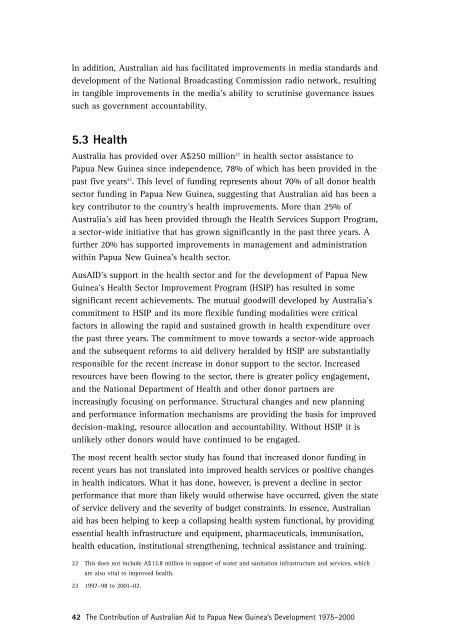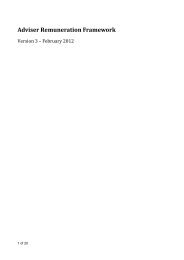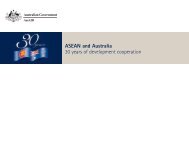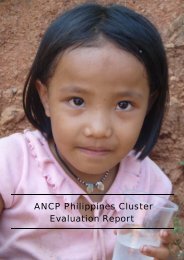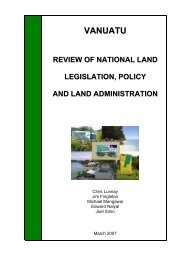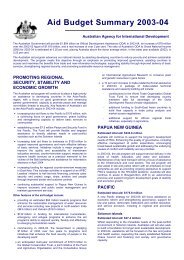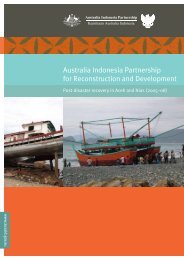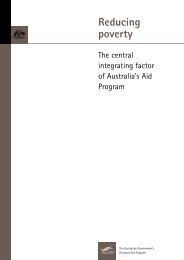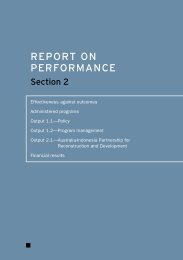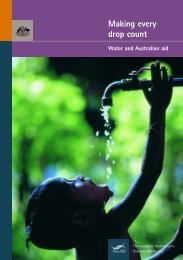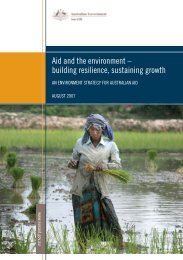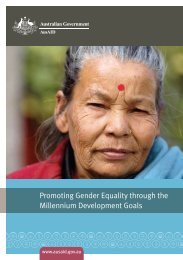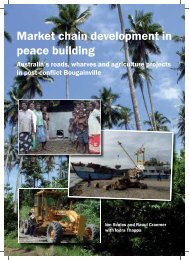In addition, <strong>Australian</strong> aid has facilitated improvements in media standards anddevelopment of the National Broadcasting Commission radio network, resultingin tangible improvements in the media’s ability <strong>to</strong> scrutinise governance issuessuch as government accountability.5.3 HealthAustralia has provided over A$250 million 22 in health sec<strong>to</strong>r assistance <strong>to</strong>Papua New Guinea since independence, 78% of which has been provided in thepast five years 23 . This level of funding represents about 70% of all donor healthsec<strong>to</strong>r funding in Papua New Guinea, suggesting that <strong>Australian</strong> aid has been akey contribu<strong>to</strong>r <strong>to</strong> the country’s health improvements. More than 25% ofAustralia’s aid has been provided through the Health Services Support Program,a sec<strong>to</strong>r-wide initiative that has grown significantly in the past three years. Afurther 20% has supported improvements in management and administrationwithin Papua New Guinea’s health sec<strong>to</strong>r.<strong>AusAID</strong>'s support in the health sec<strong>to</strong>r and for the development of Papua NewGuinea’s Health Sec<strong>to</strong>r Improvement Program (HSIP) has resulted in somesignificant recent achievements. The mutual goodwill developed by Australia’scommitment <strong>to</strong> HSIP and its more flexible funding modalities were criticalfac<strong>to</strong>rs in allowing the rapid and sustained growth in health expenditure overthe past three years. The commitment <strong>to</strong> move <strong>to</strong>wards a sec<strong>to</strong>r-wide approachand the subsequent reforms <strong>to</strong> aid delivery heralded by HSIP are substantiallyresponsible for the recent increase in donor support <strong>to</strong> the sec<strong>to</strong>r. Increasedresources have been flowing <strong>to</strong> the sec<strong>to</strong>r, there is greater policy engagement,and the National Department of Health and other donor partners areincreasingly focusing on performance. Structural changes and new planningand performance information mechanisms are providing the basis for improveddecision-making, resource allocation and accountability. Without HSIP it isunlikely other donors would have continued <strong>to</strong> be engaged.The most recent health sec<strong>to</strong>r study has found that increased donor funding inrecent years has not translated in<strong>to</strong> improved health services or positive changesin health indica<strong>to</strong>rs. What it has done, however, is prevent a decline in sec<strong>to</strong>rperformance that more than likely would otherwise have occurred, given the stateof service delivery and the severity of budget constraints. In essence, <strong>Australian</strong>aid has been helping <strong>to</strong> keep a collapsing health system functional, by providingessential health infrastructure and equipment, pharmaceuticals, immunisation,health education, institutional strengthening, technical assistance and training.22 This does not include A$13.8 million in support of water and sanitation infrastructure and services, whichare also vital <strong>to</strong> improved health.23 1997–98 <strong>to</strong> 2001–02.42 The Contribution of <strong>Australian</strong> <strong>Aid</strong> <strong>to</strong> Papua New Guinea’s Development 1975–2000
BOX 5.5 HEALTH IMPACTS OF AUSTRALIAN ASSISTANCE• Some evidence of a reduction in the number of deaths per 100,000 from malariaand pneumonia between 1996 and 2002, coinciding with increased <strong>Australian</strong>support across the health sec<strong>to</strong>r, including a $9 million project <strong>to</strong> field test an<strong>Australian</strong> candidate malaria vaccine and provide associated training andequipment.• Provided substantial support for immunisation against polio, triple antigen,tetanus <strong>to</strong>xoid, measles, tuberculosis and hepatitis B, including vaccine supplies,helping <strong>to</strong> arrest the decline in immunisation coverage after a fall in rates duringthe mid 1990s.• Immunised over 600,000 children aged under 5 years against polio. Polio has nowbeen eradicated in <strong>PNG</strong>.• Supplied drugs, vaccines and supplies essential <strong>to</strong> treating conditions such asmalaria, pneumonia and diarrhoea <strong>to</strong> over 500 health centres in 20 provinces,including 600 basic medical equipment kits and over 4,000 essential drug kits.• Conducted mobile health clinics and patrols in 8 provinces, immunising childrenagainst tuberculosis, polio and measles and providing antenatal care <strong>to</strong> mothers.• Rehabilitated <strong>PNG</strong>’s vaccine s<strong>to</strong>rage and distribution system.• Trained staff at 40 clinics in HIV/STD testing procedures.• Completed the first Demographic Health Survey in <strong>PNG</strong>, covering 19 provinces.The survey provides a significant database for planning future initiatives inreproductive and population health.• Provided approximately $5 million in goods and associated services, such assurgical equipment and supplies, ward furniture, administrative equipment such ascomputers, and ambulances, and an additional $3 million in biomedicalequipment <strong>to</strong> provincial hospitals.• Completed emergency repairs <strong>to</strong> make medical equipment at 19 provincialhospitals operational.• Reconstructed priority rural health facilities in four provinces, includinginstallation of solar panels, water tanks, water supply lines and bore pumps;renovated general and maternity wards; and constructed or rebuilt housing,<strong>to</strong>ilets, laundries and kitchens.• Upgraded four base hospitals.• Established 20 new provincial vaccine s<strong>to</strong>res, and rehabilitated 222 healthfacilities, including district vaccine s<strong>to</strong>res.• Constructed and equipped 10 new STD clinics.• Improved the level of HIV/AIDS awareness in selected urban and peri-urban areasin <strong>PNG</strong> from 80% <strong>to</strong> 97%, increased condom usage from 35% <strong>to</strong> 42%, andincreased the rate of individuals seeking AIDS tests from 9% <strong>to</strong> 18%.• Mobilised over 150 community and church groups <strong>to</strong> conduct HIV/AIDS awarenessprograms.The Contribution of <strong>Australian</strong> <strong>Aid</strong> <strong>to</strong> Papua New Guinea’s Development 1975–2000 43
- Page 5 and 6: BOXESBox 3.1 The Dutch Disease in P
- Page 7 and 8: FOREWORDAs part of a broader focus
- Page 11 and 12: programs to improve living standard
- Page 13 and 14: sector since independence, 65% has
- Page 15 and 16: 1 INTRODUCTIONThis report provides
- Page 17 and 18: Figure 2.1 Real GDP per capita in P
- Page 19 and 20: 1985 1990 1995 2000PNG HPC LIC LMC
- Page 21 and 22: significant strain on the budget an
- Page 23 and 24: • Improved central coordination a
- Page 25 and 26: Connell (1998, pp. 311-2) highlight
- Page 27 and 28: y the successful mobilisation of cu
- Page 29 and 30: 3 INTERPRETING THE DEVELOPMENT ANDG
- Page 31 and 32: The estimated increase in private c
- Page 33 and 34: 3.4 Reconciling the Growth and Deve
- Page 35 and 36: 3.5 Implications for AidTo summaris
- Page 37 and 38: Although the precise extent of the
- Page 39 and 40: program saw a decline in the overal
- Page 41 and 42: criticism that the withdrawal of Au
- Page 43 and 44: Ministerial Forum found that real p
- Page 45 and 46: management for Papua New Guinea, ov
- Page 47 and 48: 5 THE IMPACT OF AUSTRALIAN AID INPA
- Page 49 and 50: • Improved retention rates at sch
- Page 51 and 52: • Achieved operational efficienci
- Page 53 and 54: policing are being introduced, alon
- Page 55: deliver community and public servic
- Page 59 and 60: also improved 24 , and there is evi
- Page 61 and 62: 5.5 Renewable ResourcesIn total, Au
- Page 63 and 64: Land Use Management• Established
- Page 65 and 66: New Guinea needs donor financing fo
- Page 67 and 68: only assist within the context of t
- Page 69 and 70: Both within sectors and more broadl
- Page 71 and 72: However, it seems reasonable to arg
- Page 73 and 74: useful to document the findings of
- Page 75 and 76: ANNEX A EVOLUTION OF AUSTRALIAN AID
- Page 77 and 78: ANNEX B SECTOR BREAKDOWN OF AUSTRAL
- Page 79 and 80: 8 REFERENCESAhai, N., 1988, The Dev
- Page 81 and 82: Garnaut, R., and Baxter, P., 1984,
- Page 83 and 84: Growth Strategy, Final Report, prep


